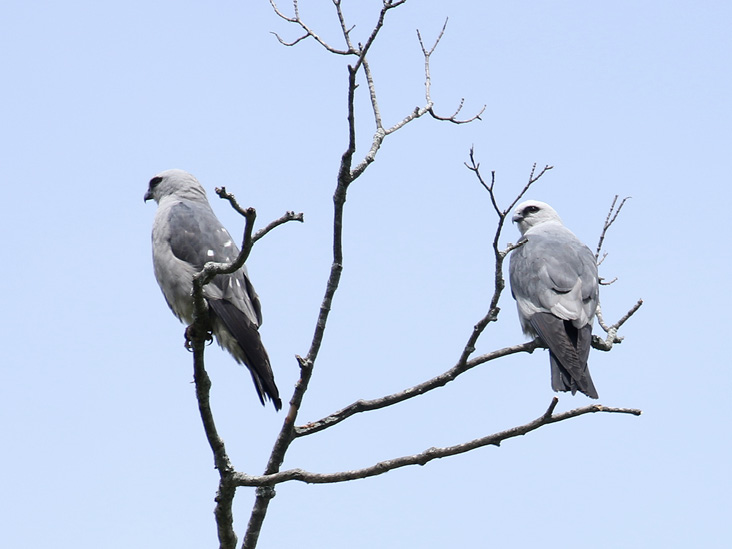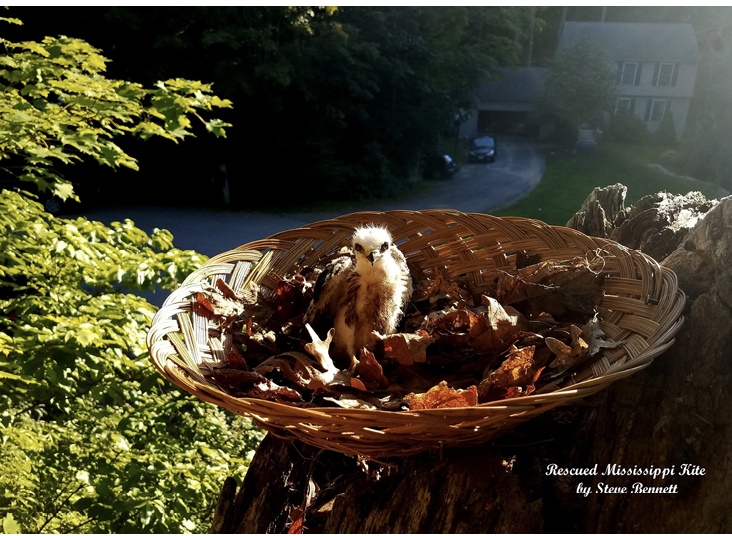Stephen Mirick

Mississippi Kites. Photograph by the author.
The small town of Newmarket, New Hampshire, which lies about 14 miles north of the Massachusetts state line, became famous in the birding world in 1998 with a visit from a Little Egret that stayed for several weeks and entertained hundreds of birders from all across the country. Newmarket is also famous as the former residence of many noteworthy birders including Ben Griffith, Lauren Kras, Kurk Dorsey, Christopher Ciccone, and yours truly. But starting in the early 2000s, the town has become famous for new residents—Mississippi Kites.
The story of Mississippi Kites nesting in New Hampshire is a remarkable one that dates back to 2004. At that time, there had been only two single observer sightings ever for the state and both of those came from the 1980s (Keith and Fox 2013). There were no unambiguous state records, so the species was on the hypothetical list according to the New Hampshire Bird Records committee.
The story began on May 30, 2004, when Robert Roy was fishing from a boat along the Lamprey River in Newmarket. He reported that he saw a Mississippi Kite land in a tree 100 feet away, where it broke off a branch and carried it away as if building a nest. The record, with good descriptive details, was belatedly submitted to the New Hampshire Rare Bird Committee; however, the committee could not in good conscience accept this record due to the implausible nature of the sighting. After all, how could it be possible that a Mississippi Kite would be building a nest in New Hampshire?
Unfortunately, Roy's record was disregarded and I had just moved out of Newmarket, so there were no birders ambitious enough to try to relocate or confirm this report in subsequent years. The story would grow stale until the spring of 2008.
On June 3, 2008, a birder named Darin Franceschini reported in his first post to NHBirds (the statewide birding email list) that he had seen a pair of Mississippi Kites along the Lamprey River in Newmarket on May 28, 2008 (Donsker 2008). He described them as having "an unmistakable white band across the secondaries and the male had bright fiery red eyes." Once again, the birding world seemed to turn its collective head and deny the implausible. How could anyone see the fiery red eyes of a Mississippi Kite in New Hampshire? Absurd!
Finally, the "cork came out of the bottle" and the story unfolded to the birding world, when birder Ben Griffith, along with Charlie Wright, were driving through Newmarket on June 14, 2008, and spotted two kites flying across South Main Street. Thanks to a few phone calls and the Internet, the entire New England birding community learned of their presence and scores of birders swarmed to Newmarket and saw the birds that day.
The story became more and more amazing almost by the hour. That first day, June 14, the kites were observed gracefully feeding together all afternoon and coming down to roost and spend the night in the same area. The next day they were found again and were seen and photographed copulating. By the third day, they were seen copulating again, and also building a nest. On, or shortly after June 17, it was thought that an egg or eggs had been laid and incubation had started. On July 18, hatching was confirmed when a single chick was seen being fed (Ben Griffith, personal communication). The chick fledged in August.
With an increase of eyes focused on Newmarket, incredibly a second nest was discovered in August of 2008, and a minimum of five adult or subadult Mississippi Kites were confirmed—all in Newmarket. Not only that, each nest successfully fledged a single chick.
The successful nesting of two pairs of kites in 2008, combined with the number of adult and subadult birds in the area that year, all support the 2004 sighting and suggests that kites had been nesting, or at least attempting to nest, in Newmarket since 2004 or earlier.

Rescued Mississippi Kite nestling. Photograph by Steve Bennett.
Between 2008 and 2016, the kites returned to nest each year, and the town of Newmarket continued to be the nexus of all kite activity. In fact, there were only a few scattered reports of individual kites in nearby towns. The primary areas of kite nesting activity were along South Main Street and Gonet Drive, less than two miles apart, and near the center of town. Each year, no more than one or two nests were found. Birders, however, spent little time in searching for additional territories or nests, which can be surprisingly difficult to find.
The 2017 nesting season was disastrous. Only a single nest was located in Newmarket. A car struck the male of that pair, and after a long period of rehabilitation the bird died when it flew into the wall of a flight enclosure. The female tried to raise a single chick by herself; however, the partly-grown chick fell out of the nest and the female would not feed the baby on the ground. The chick ultimately succumbed despite my best efforts, with help from others, in placing the baby up in a makeshift nest in a nearby tree.
Despite this nest failure and the death of an adult, encouraging reports were received at the end of the 2017 season of additional kite activity from the nearby towns of Durham and Stratham. In 2018, three nests were found with one each in Newmarket, Durham, and Stratham. The two new nest sites in Durham and Stratham were within five miles of downtown Newmarket. All three nests successfully fledged a single chick—the first time that three chicks had ever fledged in the state. During the summer of 2019, New Hampshire again had three known nest territories for Mississippi Kites in the same nest locations; however, only two of the nests were successful and two chicks fledged.
Below are a few observations I've made over the 11 years since the kites were first confirmed as nesting in New Hampshire.
- Spring Arrival Dates: Arrival dates at nest territories are generally in mid-May. My earliest recorded date is May 13; however, there appear to be reports from as early as May 9 (eBird).
- Nest Location: 100% of the nests found in New Hampshire have been in residential subdivisions with mature trees. Nests almost always have been in the front, side, or rear yards of homes. This has been convenient for monitoring the nests, most of which have been visible from road frontage or sidewalks.
- Nest Tree: The type of tree that the kites chose for their nests has varied considerably, and nests have been found in a variety of species including red oak, white pine, sugar maple, and shagbark hickory. The nest is always relatively high in the tree, under the canopy, and often difficult to see. The small scraggly nest of twigs is sometimes located in forks of outer branches and vulnerable to high wind disturbance.
- Nesting Behavior: Unlike Mississippi Kites in other parts of the country, these kites are tolerant of human activity. The birds are oblivious to anything going on below them, including dogs barking, lawn mowers blasting, kids screaming, or hordes of birders watching them from the street nearby. Some homeowners have been tolerant as well, with youngsters setting up lemonade stands for visiting birders.
- Site Fidelity: Site fidelity is strong, as would be expected, but the birds don't always use the same nest tree. Sometimes they take over the old nest or build a new nest in the same tree, or they may choose a nest tree up to a hundred yards away or even at a different street address.
- Number of Young: Only a single chick per nest has ever been confirmed for all of the nests I have observed or heard about over the past 11 years. No one has ever seen a second head sticking up out of a nest. This suggests that the kites in New Hampshire lay only a single egg. This is noteworthy because in their usual breeding range, the normal clutch size is almost always two eggs (sometimes one and rarely three [Parker 1999]). Is this a modification in their egg-laying behavior to accommodate a shorter breeding season this far north? Or could it reflect a scarcity of food when the kites arrive in May and a subsequent lack of resources that the female can put into egg laying?
- Food: Food items I've seen brought to the nests have been mostly dragonflies, cicadas, and indiscernible flying insects. One memorable observation was of one of the kites eating a bat that it dropped at my feet, then swooped down to try to catch it (unsuccessfully) before it hit the ground. In 2019, I saw an adult feed a chick a fledged juvenile Eastern Bluebird, which was the first time I saw a kite eating a bird.
- Post-Fledging Period: Adult care and feeding of the single chick continues well after fledging. The family group moves around the neighborhood but generally stays in the vicinity of the nest. Parental care is a long process that continues right up into early September, or roughly one month after fledging. The overall reproductive process appears to take roughly three months: one month of incubation, one month until fledging, and one final month until independence.
- Nest Success: Nest success seems good considering the northerly latitude for this southern species. Accurate data has not been carefully monitored over the years; however, I think that approximately 14 young kites have successfully fledged and I know of only four nest failures (eBird). Two of the failures seem to have occurred during incubation and two occurred with young in the nest. Other than the young bird that fell out of the nest in 2017, the reasons for the nest failures have been difficult to identify. I suspect at least one or more additional failures have been the result of strong storm activity and young or eggs falling from the nest. However, avian and mammalian predators are always a possibility.
- Fall Departure Dates: Successful adult Mississippi Kites care for their young into the first or second week of September and then all birds seem to disappear at once. The latest reported observation I can find for territorial birds is of a family group of three on September 11, 2016 (eBird).
References
- Donsker, D. 2008. Mississippi Kites In New Hampshire, New Hampshire Bird Records 27 (2): 34–39.
- eBird. http://www.ebird.org. Accessed: November 2019.
- Keith, A. R. and R. P. Fox. 2013. The Birds of New Hampshire. Cambridge, Massachusetts: The Nuttall Ornithological Club.
- Parker, J. W. 1999. Mississippi Kite (Ictinia mississippiensis), version 2.0. In The Birds of North America Online (A. F. Poole and F. B. Gill, eds). Ithaca : Cornell Lab of Ornithology: https://doi.org/10.2173/bna.402
Steve Mirick has been birding in New Hampshire since he was in college at the University of New Hampshire in 1981. He served as the fall editor for New Hampshire Bird Records for 20 years, and was as a member of the New Hampshire Rare Bird Committee. He has been active for many years with New Hampshire Audubon and continues to lead field trips for the Seacoast Chapter. Steve moved out of Newmarket, New Hampshire, in 2003 and now lives in Bradford, Massachusetts, but continues to be an avid birder in New Hampshire where he and his wife Jane spend most of their time chasing birds across the state.